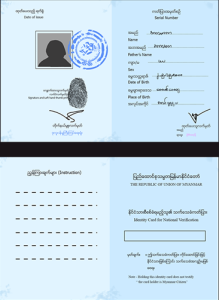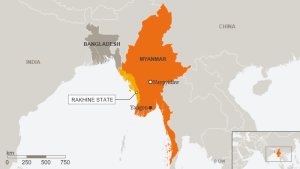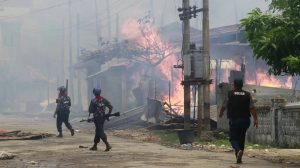Postcard 1: National Verification Card (NVC)

The 1982 Citizenship Law in Myanmar officially stripped Rohingya of citizenship, making them stateless. For the past few decades, several forms of documentation have been available to the Rohingya population; however, more recently, the National Verification Card (NVC) has become the new scheme targeting Rohingya in the attempt to erase their identity.
The NVC card is given to foreigners who go through the Citizenship Verification Process in Myanmar. Since the Rohingya Muslims of the state of Rakhine are not considered citizens, they are consequently forced to accept these cards, which label them as Bengali. Recently, Rohingya who do not accept the cards are threatened with violence, including torture, murder, and the burning of their homes. Additionally, Rohingya fishermen have been banned from going out to sea until they accept the NVC cards. This is one of the many examples of how the Rohingya population within Rakhine cannot work or travel without the ID Card, which has forced them to comply with government officials and accept the form of documentation.
I am using the NVC as a postcard to express the importance of recognition when it comes to forms of identification. Since the Rohingyas are seen as the “other” and are considered to have no connections to “the nation” when it comes to Rakhine or Myanmar as a whole, the violence towards the Rohingya is justified and keeps persisting.
Sources:
Fortifyrights. “Myanmar: New Evidence of Denial of Rohingya Citizenship.” Fortify Rights, November 5, 2020. https://www.fortifyrights.org/mya-inv-2020-01-16/.
“Myanmar Government Forces Remaining Rohingya for NVC Cards.” The Rohingya Post, July 20, 2020. https://www.rohingyapost.com/myanmar-government-forces-remaining-rohingya-for-nvc-cards/.
“NVC Card.” The Rohingya Post, April 13, 2020. https://www.rohingyapost.com/freedom-of-movement-in-rakhine-state-report-by-independent-rakhine-initiative/nvc-card-2/.
Postcard 2: Map of Rakhine

For this postcard, I chose a map that highlights the Rakhine’s location within Myanmar and bordering Bangladesh. For decades, the military in Myanmar has persecuted the Rohingya Muslims living in the region by depriving them of resources and stripping them of citizenship . Since 2016, they have launched military attacks against the populations living in Rakhine, including mass murder, beatings, gang rapes. They have also committed arson towards houses, schools, and other properties in the aim of expelling the ethnic group from the region.
Since the peak of the genocide, hundreds of thousands of Rohingya have fled to neighboring Bangladesh to escape the atrocities. This postcard helps visualize the route that those fleeing Rakhine take.
Sources:
Shams, Shamil. “Suu Kyi’s Rohingya Speech: Too Little, Too Late? – DW – 09/19/2017.” dw.com. Deutsche Welle, September 19, 2017. https://www.dw.com/en/suu-kyis-rohingya-speech-too-little-too-late/a-40581059.
Postcard 3: Visual Capture of Sittawe

The postcard above captures policemen walking towards burning buildings in Sittawe—the capital of the state of Rakhine—while residents fled burning homes and gunshots as deadly violence broke out.
I chose this postcard to incorporate some visuals of what the Rohingya Muslims are experiencing at the hands of the military. Arson, rape, murder, among other forms of violence are extremely common in the region, and I want to show that this is what Rakhine looks like amid the Rohingya Genocide. When looking at traditional postcards, one usually sees this marketed, intentional portrayal of a certain location that is meant to give off positive imagery, but for this one I intend to show the truth. The current Myanmar government refuses to comply with the United Nations Convention on the Prevention and Punishment of the Crime of Genocide. They will not let any U.N. officials conduct fact-finding missions in Rakhine, nor will they allow any forms of humanitarian aid—provided by the U.N. and its partner—enter the border. The purpose behind this is to erase the human rights abuses that are occurring (Levy 2019). I am using this postcard to show what the residents in the Rakhine State are seeing and experiencing on a daily basis.
Sources:
Coleman, Korva. “Western Myanmar Faces Religious Violence, Emergency Declared.” NPR. NPR, June 12, 2012. https://www.npr.org/sections/thetwo-way/2012/06/12/154834205/western-myanmar-faces-religious-violence-emergency-declared
Levy, Alexa. “Rohingya in Myanmar: The United Nations’ Failure to Enforce Violations of Crimes against Humanity and Genocide,” George Washington International Law Review 51, no. 2 (2019): 321-344.
